Production Notes - A View To
A Kill
Whether the timing was deliberate, to take some
of the wind from the sails of rival Bond film "Never
Say Never Again" (1983), is unclear, but the day before Kevin
McClory's film was released, EON Productions announced that Roger
Moore was to return in his seventh Bond film, announced as "From a
View To a Kill".
Moore had been resisting signing a long term
contract with EON since his original three film contract had
expired following "The Spy Who Loved
Me" (1977) and had been
negotiating with producer Albert
Broccoli on a film-by-film basis.
Moore
had twice before expressed his reluctance to continue with the
role, trying to quit before "For Your
Eyes Only" (1981) and "Octopussy"
(1983) only to be lured back by increased salaries.
|
Prior to "A
View to a Kill", Moore
again expressed his reluctance to return to the role and
again Broccoli
and Bond paymasters United Artists had tempted him back
with a salary hike. This time, however, Moore and Broccoli
came to an agreement - Moore would play Bond one last time
and then he would walk away from the role.
With Moore back in the saddle, if only
temporarily, returning director John Glen set to work on
pre-production. His preferred
choice of screenwriter, "Octopussy"s George MacDonald
Fraser, was unavailable and the script was being prepared
by Bond
series old-boy Richard Maibaum in collaboration with executive
producer Michael
G. Wilson and Broccoli. The team had noted
the explosion in available computer technology and the
public's fascination / concern with all things hi-tech
so decided that their story should centre around the planned
destruction of America's Silicon Valley.
With a title taken from one of Ian Fleming's short stories,
the trio first concocted a treatment that saw the villain,
deranged industrialist Max
Zorin, attempting to wipe out
the west's primary source of high technology by re-directing
the path of Halley's Comet. That fanciful notion was dropped
early on, perhaps fearing that it would return the series
to the excesses of the 70s. |
|
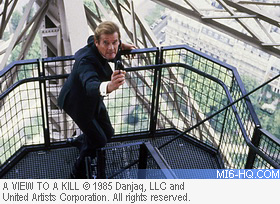
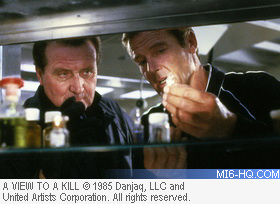
|
Christopher Walken, who had scored such a huge
success in "The Deer Hunter" and who had appeared alongside Sean
Connery in "The Anderson Tapes" (1971) was cast as the
insane Zorin, beating of competition from the likes of Lee Van
Cleef
and Rutger
Hauer. Ironically, Walken had also been among the cast of Michael
Cimino's disastrous "Heaven's Gate" (1980), the catastrophic
failure of which had almost left the United Artist's bankrupt.
Joining forces with Bond against Zorin's evil
machinations was the third of TV's The Avengers to defect to
the Bond camp. Patrick Macnee had
feared that he would never get the chance to appear in a Bond
film after he had criticised
Broccoli for 'poaching' Honor
Blackman away from The Avengers
to appear in "Goldfinger" (1964).
But Macnee had appeared in the the TV movie "Sherlock Holmes
in New York" (1976),
playing Dr Watson
to Roger Moore's Sherlock Holmes and Moore was keen to work with
Macnee again. On Moore's recommendation, Macnee was cast as undercover
agent Sir Godfrey Tibbett.
|
The new Bond girl was going to be former
Charlie's Angels star Tanya
Roberts. Broccoli had seen
Roberts in "The Beastmaster" (1982) and had been
so impressed by what he saw that he decided that she was
just right for the part of geologist
Stacy Sutton.
Perhaps thee least likely, but certainly
one of the most distinctive of Bond girls, was former model
and disco diva
Grace Jones, the athletic
and striking co-star of "Conan the Destroyer" (1984). Her
work on that film had
so impressed Broccoli that she was quickly added to his
'shopping
list'
of actors for the now subtlety retitled "A View To A Kill".
But one long-standing Bond girl was preparing
to make her farewell performance - when Moore bowed out
of the
series, so would Lois
Maxwell who, along with Albert Broccoli,
was the only surviving member of the team that had created
"Dr No" back in 1962. Maxwell had asked that her character
go out with a bang, being killed of in the course of duty.
Broccoli vetoed that plan but Maxwell finally got to film
a proper goodbye scene a few years later when she appeared
opposite Terence Connolly [as M] in an advert for Brook
Street Employment Agency - Moneypenny was seen signing
up with the agency after she has handed in her notice to
M! |
|
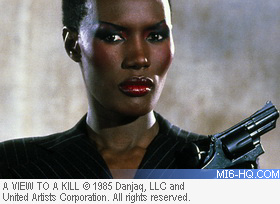
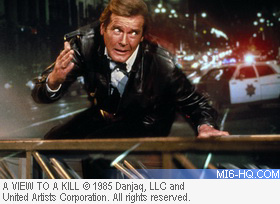
|
Pre-production was going along nicely when suddenly
disaster struck. The immense, custom-built 007 sound stage that
had been built at Pinewood to house "The
Spy Who Loved Me" (1977)
was severely damaged in a fire on 27 June 1984 shortly before
it was due to house Ridley Scott's "Legend" (1984). With
"A View To A Kill" due to move in towards the end of the year,
the
race
was on to almost entirely rebuild the stage in time.
With a budget of $30 million under its belt,
the production kicked off in July 1984 when the second unit began
its work. Moore joined the main unit at Pinewood on 1 August
and from their home base, the crew would visit Royal Ascot for
the racing scenes, and both a waterlogged quarry near Staines
and the Amberley Chalk Pits Museum in West Sussex for the scenes
around the entrance to the mineshaft.
|
The teaser was shot on location in Iceland
before the main unit decamped to France to shoot in both
an automated
Renault production facility (which stood in for the warehouse
hidden beneath Zorin's stables) and where the spectacular
Eiffel Tower parachute jump would be performed by Bond
veteran B.J. Worth. The impressive palatial home of Max
Zorin was recreated at the 18th century chateau at Chantilly.
A large part of the schedule was taken up with the San
Francisco shoot. All of the stunt scenes on the Golden
Gate Bridge and the nocturnal chase through the city on
a fire engine were staged by the second unit while the
main unit worked on the scenes in Chinatown.
On 7 January 1985, the newly rebuilt 007 stage, now renamed
the Albert R. Broccoli 007 stage in honour of the producer
who had made Pinewood his second home, was officially reopened,
though it had been finished some time before and was now
playing host to Peter
Lamont's huge set representing the
interior of Zorin's mine workings. The finale called on
the services of over 100 stuntmen, the largest stunt team
ever assembled for a Bond film. |
|
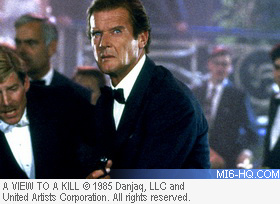
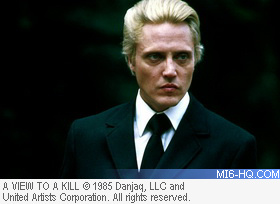
|
Prior to release, EON had one last complication
to sort out. It had come to their attention that there already
existed a real
life company named Zoran Ladicorbic Ltd owned and run by the
fashion designer Zoran. EON decided that discretion was the
better part of valour and ran a disclaimer at the beginning of
the film, distancing their entirely fictional Zorin from any
real person or organisation.
John Barry was again charged with creating the soundtrack for
the film and, for the first time in the series history, he approached
a pop group rather than a solo artist to perform the title song.
Duran Duran were chosen because they had enjoyed tremendous success
on both sides of the Atlantic. Released slightly ahead of the
film itself, the single became the most successful Bond theme
tune so far, reaching number two in the UK singles charts and
going all the way to number one in the US Billboard chart.
In a reversal of recent trends, "A View To A
Kill" opened in the States first, on 24 May 1985. It's UK premiere,
on Wednesday
12 June, was, as usual, held at the Odeon Leicester Square and
was attended by the Prince and Princess of Wales, their third
Bond premiere. Admissions were significantly down on "Octopussy",
particularly in the States where the box-office dollars from
paying customers fell from $225 million to a relatively
measly
$161.6
million.
Moore himself, finally saying goodbye to a character
who had been a part of his life for over a decade, was particularly
disappointed
with the direction that "A View To A Kill" had taken: "I
was horrified on the last Bond I did. Whole slews of sequences
where
Christopher Walken was machine-gunning hundreds of people. I
said 'That wasn't Bond, those weren't Bond films.' It stopped
being what they were all about. You didn't dwell on the blood
and the brains spewing all over the place."
With Moore leaving for pastures new, and audiences
apparently leaving with him, the way was open for EON to take
stock and
prepare the way for a new era for Bond.